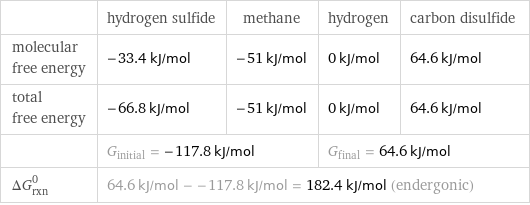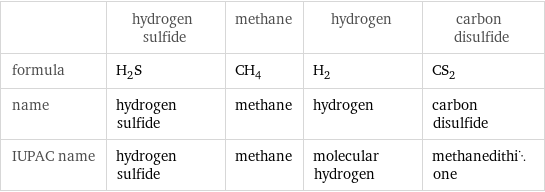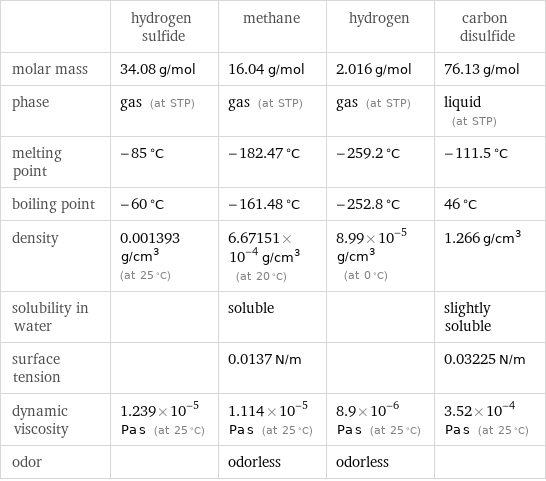Input interpretation

H_2S hydrogen sulfide + CH_4 methane ⟶ H_2 hydrogen + CS_2 carbon disulfide
Balanced equation

Balance the chemical equation algebraically: H_2S + CH_4 ⟶ H_2 + CS_2 Add stoichiometric coefficients, c_i, to the reactants and products: c_1 H_2S + c_2 CH_4 ⟶ c_3 H_2 + c_4 CS_2 Set the number of atoms in the reactants equal to the number of atoms in the products for H, S and C: H: | 2 c_1 + 4 c_2 = 2 c_3 S: | c_1 = 2 c_4 C: | c_2 = c_4 Since the coefficients are relative quantities and underdetermined, choose a coefficient to set arbitrarily. To keep the coefficients small, the arbitrary value is ordinarily one. For instance, set c_2 = 1 and solve the system of equations for the remaining coefficients: c_1 = 2 c_2 = 1 c_3 = 4 c_4 = 1 Substitute the coefficients into the chemical reaction to obtain the balanced equation: Answer: | | 2 H_2S + CH_4 ⟶ 4 H_2 + CS_2
Structures

+ ⟶ +
Names

hydrogen sulfide + methane ⟶ hydrogen + carbon disulfide
Reaction thermodynamics
Gibbs free energy

| hydrogen sulfide | methane | hydrogen | carbon disulfide molecular free energy | -33.4 kJ/mol | -51 kJ/mol | 0 kJ/mol | 64.6 kJ/mol total free energy | -66.8 kJ/mol | -51 kJ/mol | 0 kJ/mol | 64.6 kJ/mol | G_initial = -117.8 kJ/mol | | G_final = 64.6 kJ/mol | ΔG_rxn^0 | 64.6 kJ/mol - -117.8 kJ/mol = 182.4 kJ/mol (endergonic) | | |
Equilibrium constant
![Construct the equilibrium constant, K, expression for: H_2S + CH_4 ⟶ H_2 + CS_2 Plan: • Balance the chemical equation. • Determine the stoichiometric numbers. • Assemble the activity expression for each chemical species. • Use the activity expressions to build the equilibrium constant expression. Write the balanced chemical equation: 2 H_2S + CH_4 ⟶ 4 H_2 + CS_2 Assign stoichiometric numbers, ν_i, using the stoichiometric coefficients, c_i, from the balanced chemical equation in the following manner: ν_i = -c_i for reactants and ν_i = c_i for products: chemical species | c_i | ν_i H_2S | 2 | -2 CH_4 | 1 | -1 H_2 | 4 | 4 CS_2 | 1 | 1 Assemble the activity expressions accounting for the state of matter and ν_i: chemical species | c_i | ν_i | activity expression H_2S | 2 | -2 | ([H2S])^(-2) CH_4 | 1 | -1 | ([CH4])^(-1) H_2 | 4 | 4 | ([H2])^4 CS_2 | 1 | 1 | [CS2] The equilibrium constant symbol in the concentration basis is: K_c Mulitply the activity expressions to arrive at the K_c expression: Answer: | | K_c = ([H2S])^(-2) ([CH4])^(-1) ([H2])^4 [CS2] = (([H2])^4 [CS2])/(([H2S])^2 [CH4])](../image_source/2c51b650c61dc0d75c8416a3a550a615.png)
Construct the equilibrium constant, K, expression for: H_2S + CH_4 ⟶ H_2 + CS_2 Plan: • Balance the chemical equation. • Determine the stoichiometric numbers. • Assemble the activity expression for each chemical species. • Use the activity expressions to build the equilibrium constant expression. Write the balanced chemical equation: 2 H_2S + CH_4 ⟶ 4 H_2 + CS_2 Assign stoichiometric numbers, ν_i, using the stoichiometric coefficients, c_i, from the balanced chemical equation in the following manner: ν_i = -c_i for reactants and ν_i = c_i for products: chemical species | c_i | ν_i H_2S | 2 | -2 CH_4 | 1 | -1 H_2 | 4 | 4 CS_2 | 1 | 1 Assemble the activity expressions accounting for the state of matter and ν_i: chemical species | c_i | ν_i | activity expression H_2S | 2 | -2 | ([H2S])^(-2) CH_4 | 1 | -1 | ([CH4])^(-1) H_2 | 4 | 4 | ([H2])^4 CS_2 | 1 | 1 | [CS2] The equilibrium constant symbol in the concentration basis is: K_c Mulitply the activity expressions to arrive at the K_c expression: Answer: | | K_c = ([H2S])^(-2) ([CH4])^(-1) ([H2])^4 [CS2] = (([H2])^4 [CS2])/(([H2S])^2 [CH4])
Rate of reaction
![Construct the rate of reaction expression for: H_2S + CH_4 ⟶ H_2 + CS_2 Plan: • Balance the chemical equation. • Determine the stoichiometric numbers. • Assemble the rate term for each chemical species. • Write the rate of reaction expression. Write the balanced chemical equation: 2 H_2S + CH_4 ⟶ 4 H_2 + CS_2 Assign stoichiometric numbers, ν_i, using the stoichiometric coefficients, c_i, from the balanced chemical equation in the following manner: ν_i = -c_i for reactants and ν_i = c_i for products: chemical species | c_i | ν_i H_2S | 2 | -2 CH_4 | 1 | -1 H_2 | 4 | 4 CS_2 | 1 | 1 The rate term for each chemical species, B_i, is 1/ν_i(Δ[B_i])/(Δt) where [B_i] is the amount concentration and t is time: chemical species | c_i | ν_i | rate term H_2S | 2 | -2 | -1/2 (Δ[H2S])/(Δt) CH_4 | 1 | -1 | -(Δ[CH4])/(Δt) H_2 | 4 | 4 | 1/4 (Δ[H2])/(Δt) CS_2 | 1 | 1 | (Δ[CS2])/(Δt) (for infinitesimal rate of change, replace Δ with d) Set the rate terms equal to each other to arrive at the rate expression: Answer: | | rate = -1/2 (Δ[H2S])/(Δt) = -(Δ[CH4])/(Δt) = 1/4 (Δ[H2])/(Δt) = (Δ[CS2])/(Δt) (assuming constant volume and no accumulation of intermediates or side products)](../image_source/205b7570ae96681ec2ab43e6d46dac75.png)
Construct the rate of reaction expression for: H_2S + CH_4 ⟶ H_2 + CS_2 Plan: • Balance the chemical equation. • Determine the stoichiometric numbers. • Assemble the rate term for each chemical species. • Write the rate of reaction expression. Write the balanced chemical equation: 2 H_2S + CH_4 ⟶ 4 H_2 + CS_2 Assign stoichiometric numbers, ν_i, using the stoichiometric coefficients, c_i, from the balanced chemical equation in the following manner: ν_i = -c_i for reactants and ν_i = c_i for products: chemical species | c_i | ν_i H_2S | 2 | -2 CH_4 | 1 | -1 H_2 | 4 | 4 CS_2 | 1 | 1 The rate term for each chemical species, B_i, is 1/ν_i(Δ[B_i])/(Δt) where [B_i] is the amount concentration and t is time: chemical species | c_i | ν_i | rate term H_2S | 2 | -2 | -1/2 (Δ[H2S])/(Δt) CH_4 | 1 | -1 | -(Δ[CH4])/(Δt) H_2 | 4 | 4 | 1/4 (Δ[H2])/(Δt) CS_2 | 1 | 1 | (Δ[CS2])/(Δt) (for infinitesimal rate of change, replace Δ with d) Set the rate terms equal to each other to arrive at the rate expression: Answer: | | rate = -1/2 (Δ[H2S])/(Δt) = -(Δ[CH4])/(Δt) = 1/4 (Δ[H2])/(Δt) = (Δ[CS2])/(Δt) (assuming constant volume and no accumulation of intermediates or side products)
Chemical names and formulas

| hydrogen sulfide | methane | hydrogen | carbon disulfide formula | H_2S | CH_4 | H_2 | CS_2 name | hydrogen sulfide | methane | hydrogen | carbon disulfide IUPAC name | hydrogen sulfide | methane | molecular hydrogen | methanedithione
Substance properties

| hydrogen sulfide | methane | hydrogen | carbon disulfide molar mass | 34.08 g/mol | 16.04 g/mol | 2.016 g/mol | 76.13 g/mol phase | gas (at STP) | gas (at STP) | gas (at STP) | liquid (at STP) melting point | -85 °C | -182.47 °C | -259.2 °C | -111.5 °C boiling point | -60 °C | -161.48 °C | -252.8 °C | 46 °C density | 0.001393 g/cm^3 (at 25 °C) | 6.67151×10^-4 g/cm^3 (at 20 °C) | 8.99×10^-5 g/cm^3 (at 0 °C) | 1.266 g/cm^3 solubility in water | | soluble | | slightly soluble surface tension | | 0.0137 N/m | | 0.03225 N/m dynamic viscosity | 1.239×10^-5 Pa s (at 25 °C) | 1.114×10^-5 Pa s (at 25 °C) | 8.9×10^-6 Pa s (at 25 °C) | 3.52×10^-4 Pa s (at 25 °C) odor | | odorless | odorless |
Units
